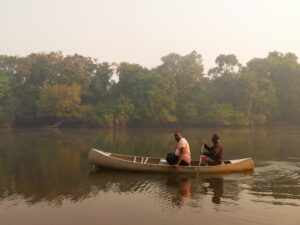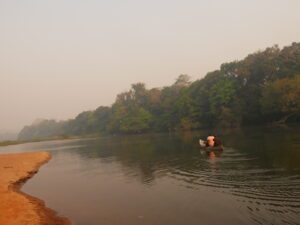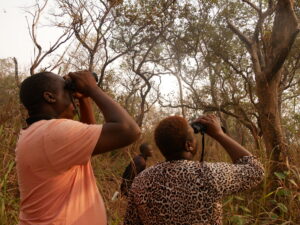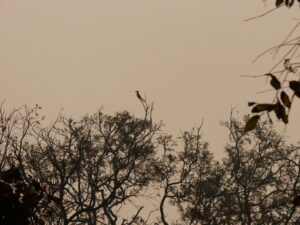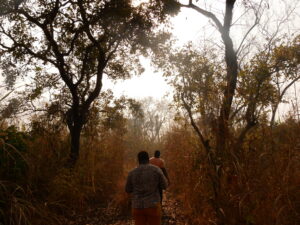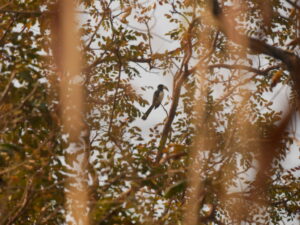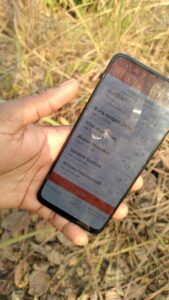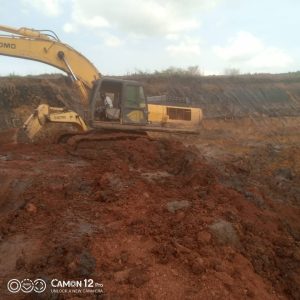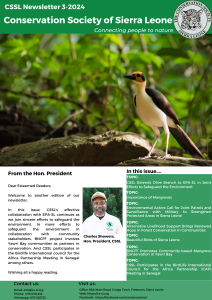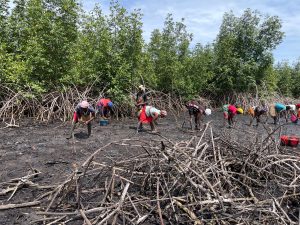Birds are important indicators for the health of ecosystems. This is one reason why bird counting is an important part of our work as Conservation Society of Sierra Leone (CSSL). As there are still many areas in our country for which the species and numbers of birds are not documented yet, we are trying to add our bit to change this situation and to make sure that the state of our environment and our ecosystems are well documented and observed.
Birds are Indicators for the State of the Ecosystem
One important bird area which is not yet officially recognised as one is the area of Outamba-Kilimi National Park (OKNP) and its surrounding. Through funds of the ABC project (African Bird Clubs), a small team of CSSL went to OKNP, close to the Guinea border to observe and document the birds there. I was lucky to be able to join them. I have to admit, it was my first bird watching experience.
Together with Papanie Bay-Sesay, CSSL´s Senior Biodiversity Officer and Andrea Haffner, CSSL`s Community Engagement Officer, we conducted two bird watching tours in and around the National Park. As I said before, for me it was my first bird watching experience. So, I was a bit excited on Saturday morning when we started early to cross the Kaaba River at OKNP in a small boat to start our first walk and bird counting. While we were waiting for the boat, we already saw the first birds flying by – an African Palm Swift and a Palmnut Vulture. A very good start. In the forest, there were a lot of Swifts, Orioles, Common Bulbuls and Bee-Eaters. We heard and saw the Blue-Spotted Wood Doves and Vinaceous Doves several times. We were able to observe a group of tiny birds in the high grass and saw sunbirds passing by. At one time, we saw the Silhouette of a Pied Hornbill framed against the rising sun. When we reached back to the river to cross it again, five Little Egrets were waiting for us on the other side and suddenly, two Great Blue Turacos were flying across the river right in front of us!
Here are some impressions from the our bird counting activities:
|
|
|
|
|
|
|
|
|
|
|
|
Birds are Everywhere – not only in the forests
For me as a beginner in bird watching, it was very amazing to see how many different birds we could spot in a short period of time and how easy my colleagues were able to name them. Just by the shapes of their beaks, their colors, their tails, the way they spread their wings and the bird calls. At least sometimes they also had to enquire from the book to identify the exact name of the birds. I was very proud that by the end of the first day I already learned some new names and was able to name some of the birds we saw. On a boat tour on the river in the late afternoon, I spotted the Great Blue Turacos again, as well as a Western Grey Plantain Eater, a violet-backed starling, a Yellow-billed Kite, a Long-tailed Cormorant, and a shiny little Kingfisher as well as many other birds who live close to the water.
When I was surprised at the first day about the huge number of species we could spot at the Park, I was even more impressed by our bird counting tour the next morning. This time we didn´t walk through the forest. We walked along a road 30 minutes outside of the Outamba-Kilimi. We were able to spot Common Bulbuls again, a lot of Village Weavers, Swifts, Sunbirds and some of the other birds we already saw the day before. But at some points even my two bird watcher colleagues got excited. For example, when we spotted a Blue Bellied Roller. I must admit, this bird is really special. Not only that the feathers are nice and shiny, it´s also the way it moves the wings when it is flying. While we were walking along the road, to our left hand side was high grass, to our right hand side was some forest, and directly in front of us a bird crossed the road. My colleague was sure it was a Senegal Coucal. But my other colleague and I were very sure that the wings were bright red. That didn´t fit to the picture of the Coucal whose wings are more of a reddish brown. The discussion took a while but then we decided to agree that the wings were red and not brown. We became sure it was a Guinea Turaco from its structure and colours after consulting the field guide. Half an hour later, another bird crossed our way. This time it was clear to all of us: reddish brown wings – it must have been a Senegal Coucal. So, all of us were very happy in the end. We spotted some really special birds and were ready to head back to Freetown.
The BirdLaserApp – fun for beginners and twitchers
For the documentation of the sightings, we used the BirdLaserApp. This app is very easy to use and helps to document sightings of birds all around the world. All you have to do is to download the app to your smartphone (Download the BirdLaserApp now), start a bird counting activity and give it a name. The GPS will find your location. For the next two hours all you have to do is to watch out for birds and enter their names and numbers in the app. My advice as a beginner is, to ask some experienced bird watchers to join you for the first trip. You can learn from them how to identify and spot the birds and of course, they will be able to teach you some of the names.
Nearly 40 species in two hours
One of the nice things of the app: In the end you will see which kind of birds you saw that day and how many species you have spotted. And you even don´t have to go to the forest. You can do the bird watching and bird counting wherever you are. In the forest, on the street, at the beach, close to a river, when you go for a walk… We spotted nearly 40 species at each activity we conducted. I am already looking forward to my next bird watching activity and recommend it to all of you who haven´t had this experience yet.


